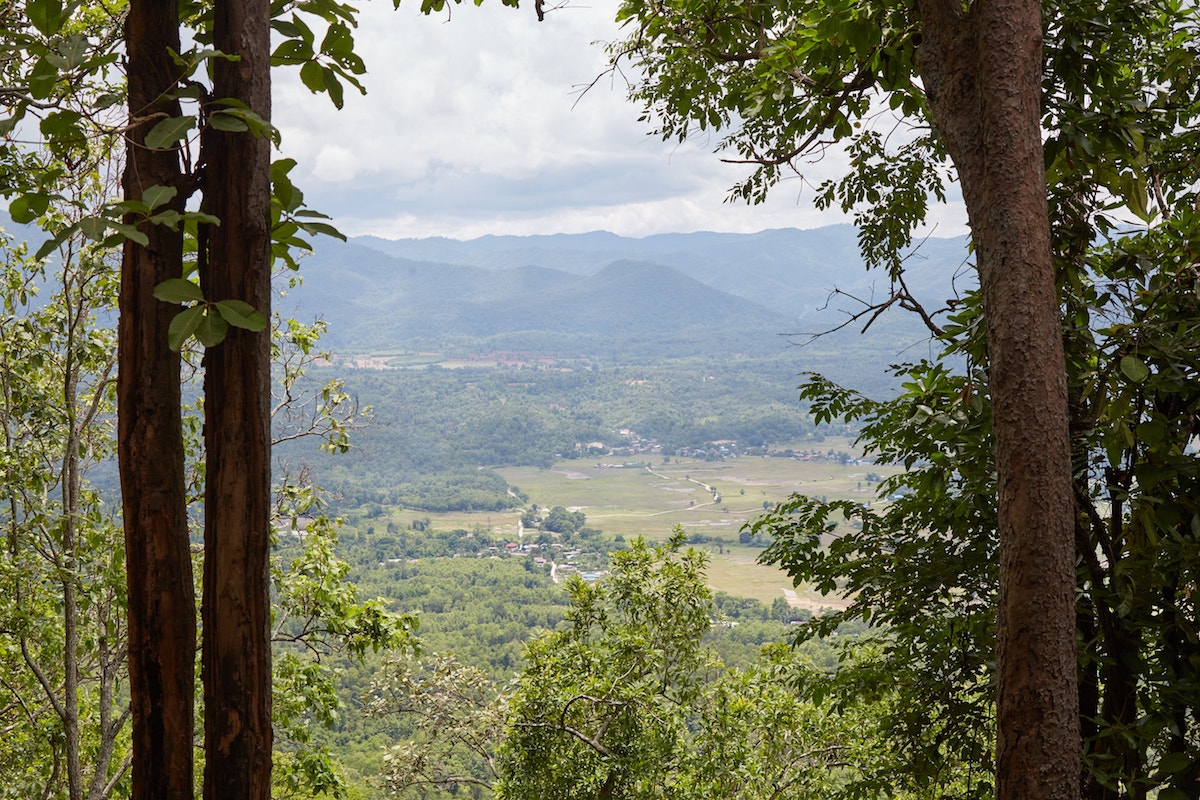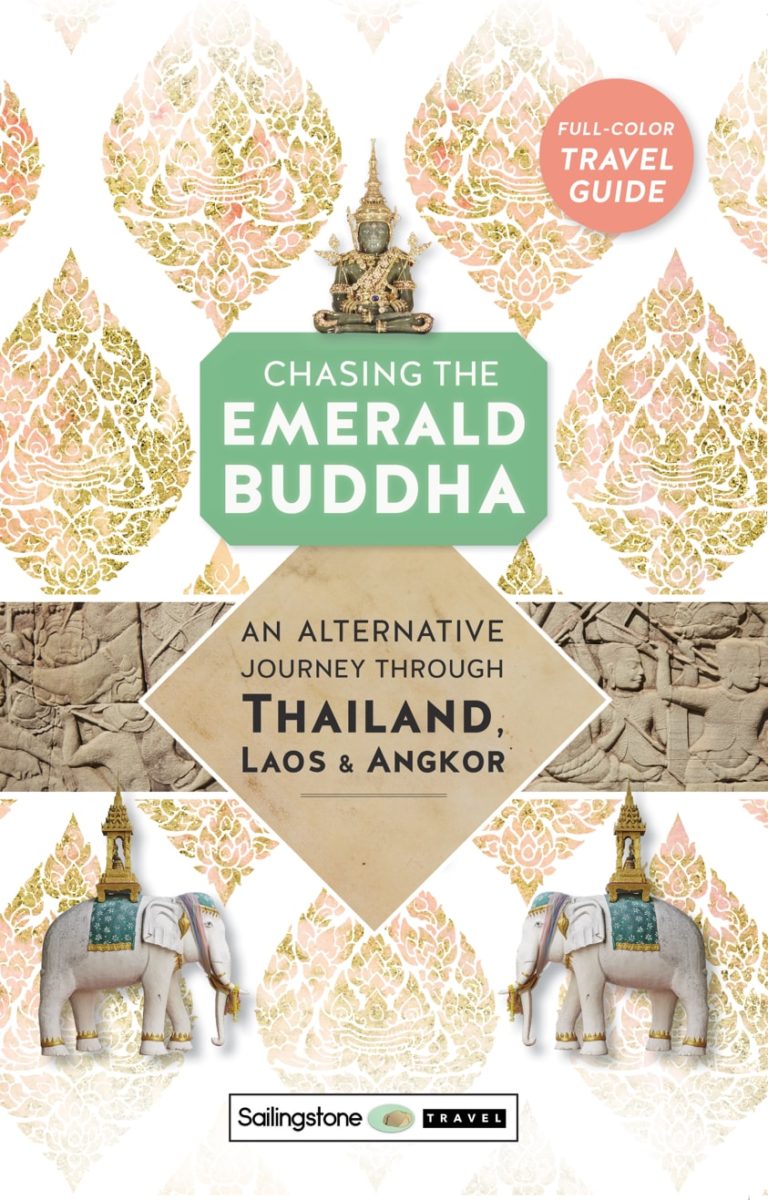Last Updated on: 8th December 2022, 09:28 am
Completed in 2015, Lampang Province’s Wat Chalermprakiat is one of Thailand’s most spectacular mountain temples. Many who come across pictures of its misty peaks capped with white pagodas immediately want to know where it is. But the temple is in such a remote location that few actually ever make it there.
My case was no different. Despite extensive travels around the Lanna region, I’d put off a visit for many months since first learning about it. But finally, shortly before leaving Thailand, I knew that I finally had to make arrangements to go and see this majestic landscape with my own eyes.
Visiting Wat Chalermprakiat
Getting to see the dream-like views of the pagodas on the mountaintop requires a number of steps. First, you’ll need to arrange private transport to the temple’s official entrance (more at the very bottom). Note that since the temple is situated within a national park, foreign visitors will have to pay the 200 baht entrance fee typically required at such places in Thailand. On top of that, a required 60 baht fee goes to transport further up the mountain. And only from there can you finally start your hike.
I hopped in the back of a converted pickup truck with an extended Thai family of 6 who happened to arrive around the same time. The truck shot up the steep hill like a rocket. And after what had already been a windy and bumpy ride from Chiang Mai, I was just barely holding it together. The ride lasted only a couple of minutes but felt like half an hour. I got out of the vehicle and took some deep breaths of fresh mountain air before the dizziness eventually subsided.




The base of the main area contains some bathrooms, a small cafe and a strange, tacky replica of a cave shrine that seems to have been put together with plaster. And also accessible from this level is a new Buddha footprint shrine, though I’d go on to see that later.
Even from here, the views of the surrounding Lampang countryside were excellent, and I was eager to see more. And so I began my ascent up the hiking trail. The ‘trail’ largely consists of metal and wooden staircases which take pilgrims a further 800 meters up the mountain.



The way up is pretty straightforward. And while you may need to take a couple of breathers along the way, it’s nothing too extreme. All in all, the reasonably fit can reach the highest level in around 20 minutes of climbing. There are also railings to hold onto for those who might need some assistance.
Before my visit, I had little idea of what to expect at the top, and I was very curious to see how the temple was actually laid out. As Wat Chalermprakiat gets few visitors, most of the pictures I could find were only of the chedis far off in the distance. I had no idea how big they really were, how close you could get to them, or what type of other structures the temple contained. As I approached the last couple of steps, I knew that I would soon get my answer.

Arriving at the top, I noticed a few chedis right in front of me. They appeared as if someone chopped the top quarter off of a regular chedi and placed it right on top of a rock.
I headed down a narrow path to my right. Passing by a robed monk who was sitting outside by himself, I arrived at a viewing platform. Not only did I get clear views of the lush green countryside, but from here I could clearly see the other buildings that make up Wat Chalermprakiat.
In addition to a small pavilion housing a large bell, the temple consists of two modest structures that appear to be more like cabins than your typical viharn or ubosot.



All in all, the main temple area which visitors actually have access to is quite small. Yet it doesn’t feel that way considering the vastness of the surroundings. I spent some time at the platform, taking in the scenes of rural Lampang’s lush greenery before moving onward.

In addition to some smaller white ones, the main temple also features its own central chedi . It’s a beautiful yet quite unusual design. Above a large white base, the top portion of the chedi is mostly gold. But it’s also decorated with blue and white tiles to create an original and appealing design.
Meanwhile, small Buddha images inhabit its niches, which you can take a closer look at thanks to another platform just off to the side.






I walked back down to the central portion of the temple and struck the large bell. I then proceeded to one of the cabin-like rooms (likely the ubosot). Situated on a low but wide altar were various Buddha images, positioned above large pots of incense that were placed on the floor. Unlike the other structures, this one had walls on all four sides, indicating that it was primarily designed for meditation or specific rituals.

Walking up a small staircase I then arrived at a much more open and airy structure – presumably the main viharn. This building also contained an altar with various statues. But giving visitors a spot from which to view the temple’s most impressive scenery seems to be its main objective. The wind at the top of the mountain rings the numerous small bells hanging down from the ceiling, adding to the tranquility of the atmosphere.






From the back of the viharn, looking away from the altar, the temple’s trademark vantage point comes into vision. There are around a dozen chedi tops placed atop various mountain karsts, making the natural rock appear to be the base of the chedis themselves.
But who placed them there, and how did they do it? The visionary behind the project was a monk named Phrathep Visutthiyarn. According to this article, he also happens to be the abbot of Wat Analayo Thippayaram in neighboring Phayao.
And together, he and around 40 followers spent nearly a decade transporting the temple parts up the mountain, assembling it piece by piece. Yet that explanation still doesn’t quite explain how they were able to get up to that part of the mountain – let alone work there!






I took my time to further appreciate my surroundings, enjoying the last moments of solitude before the local family I’d ridden the truck with with would eventually complete their hike. The fact that I finally made it to this place – one that had been on my Thailand bucket list for so many months – took awhile to sink in.
Over to the right, far in the distance, I noticed even more white chedis atop some distant crags below. I squinted at the spot, trying to wrap my head around how the workers were able to place them there without getting killed.
Perhaps one day, a documentary will come out about the temple’s construction. Yet I also wouldn’t have a problem with never getting to peek behind the curtain. The mystery of its construction only helps add to Wat Chalermprakiat’s intrigue.



During your visit, one thing you’ll notice all around the area are multiple pieces of long white rope. Not only are there threads inside the small structures, but they’ve even been tied across the mountaintop, connecting distant pagodas to one another! But why?
According to local Buddhist belief, things like relics and sacred parts of a temple are energetically charged with spiritual energy. One way to transfer this energy from one object to another, or share it amongst multiple objects, is with a white thread.
Buddhists believe them to act as something of an electric cable, but for spiritual energy rather than electricity. While by no means uncommon at temples in Thailand, it’s certainly something to see here spread across entire mountain peaks.



After one more look around the area, it was time to start the hike back down. Arriving at the lower level, I went over to check out the Buddha footprint shrine, only to discover that it was still very much under construction.
Though officially opened in 2015, Wat Chalermprakiat may still be a work in progress. And during a future visit to Thailand, I look forward to another ascent up the mountain to see how things have changed.



Returning back to the small parking lot, I found a songthaew driver waiting for passengers. After several more minutes, he concluded that no one else would be coming, and I made the twisty descent back down to the lower level alone. Though Wat Chalermprakiat was far from being a cheap or easy place to get to, the trip was well worth it.

Additional Info
Wat Chakermprakiat can be visited as a day trip from either Chiang Mai or Lampang. It’s about a couple hour drive each way from either.
As mentioned above, there is no public transport to Wat Chalermprakiat. For those departing from the Lampang area, it’s now possible to visit the temple as part of a small tour.
From Chiang Mai, you can also hire a private driver for the day. Prices can vary greatly depending on the company and the size of the vehicle. The cheapest deal you’re likely to find is around 3,000 baht for a smaller car, which is not too bad if you’re splitting it with other people. Remember that the driver will also have to wait for you and then take you all the way back.
The other option is to rent a motorbike and go there yourself. I generally don’t recommend people do this because 1.) Thailand has the most road fatalities of any country in the entire world and 2.) it is highly unlikely that your insurance company will cover you in case of an accident, even if you’re properly licensed.
If you still want to get there on your own, this article has some good advice on which routes to take from Chiang Mai.
If you’re just in Chiang Mai for a short time, staying in the Old City is a good idea. If you look at a map of the city, you will spot a square surrounded by water. Staying anywhere within or just outside of the square would be fine, as you can easily get around the Old City on foot. Most of Chiang Mai’s prominent temples and other historical sites are located here.
The other best area to stay is the Nimman district mentioned in the article above. This is a reference to the general area around Nimmanhaemin Road. Basically, if you’re within walking distance of Maya shopping mall, you’re in Nimman. This is where you’ll find a lot of Chiang Mai’s trendy cafes and restaurants, while new shopping complexes are popping up all the time. At the same time, though, there’s no shortage of cheap, local eats. Furthermore, the location is conveniently located in between Doi Suthep and the Old City.
For those basing themselves in Lampang city, and who want to to sightseeing around town, I recommend a hotel called Regent Lodge Lampang, nearby the Wang River. Lampang is divided into two sections: the old part (north of the river) and the new part (south of the river). While Regent Lodge is south of the river, it’s an easy walking distance from the bridge, making many of Lampang’s main attractions reachable by foot.
Since Lampang gets virtually no foreign tourists, you’ll have a hard time finding restaurants with English menus. Another good point of Regent Lodge Lampang is that they have a restaurant with an English menu on site. There’s also an option for a breakfast buffet.

Pin It!

